Commentary on Esther the Cold War Kitty
by Alice Shirrell Kaswell, AIR staff
The book Esther the Cold War Kitty is legendary. Written at the height of the Cold War, it was intended as propaganda for children in the West. Some historians suggest that the book was written by Soviet agents intending that the West would publish it and then suffer public embarrassment. Other historians dismiss this latter view as nonsense. For reasons that have not yet been made public, the book was never published. The true identity of the author has never been revealed.
We have obtained a copy -- one of the three copies known to be in existence -- of the book. As a public service, in this issue of the Annals of Improbable Research, we present three of its chapters: “Esther the Cold War Kitty,” “Esther and the Gear Factory,” and “Esther and the Oil Field.”
First, though, here is a perhaps relevant document produced by the CIA. It was made public under the Freedom of Information Act (the legwork in unearthing it was done by Jeffrey Richelson, a senior fellow at the National Security Archive in Washington). Shortly after its release in 2001, a report about it in The Guardian explained that:
[A] memo dated 1967 on “Views of Trained Cats” looks into the possibility of surgically inserting microphones and transmitters into cats and using them as walking bugs. The operation was codenamed “Acoustic Kitty” and was a resounding failure.
Having wired their first trained cat for sound, they released it near a park with strict orders to eavesdrop on two men on a bench, but the poor animal was run over by a taxi before it had taken more than a few steps towards its target.
The CIA researchers came to the conclusion that they could train cats to move short distances, but that “the environmental and security factors in using this technique in a real foreign situation force us to conclude that for our (intelligence) purposes, it would not be practical.”
A section of the document is reproduced below.
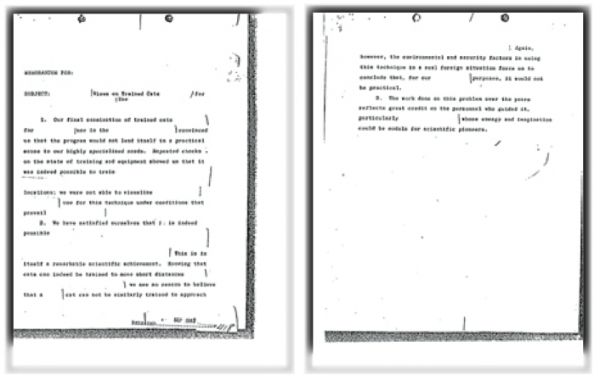
Questions abound. Was the Acoustic Kitty project related to the Esther the Cold War Kitty book? Or was it in some way a reply to, or reaction against it? Was either project entirely the work of western operatives, or was one or both in some way an attempt by the Soviet Union to gull its rival into doing something that might look foolish to the American public? Perhaps we will never have definitive answers to any of these wonderings. Nonetheless, both Esther the Cold War Kitty and the Acoustic Kitty project are fascinating research objects for historians and students of international relations.
(Thanks to investigator Charles Bergquist for bringing the Acoustic Kitty project to our attention.)
Esther the Cold War Kitty
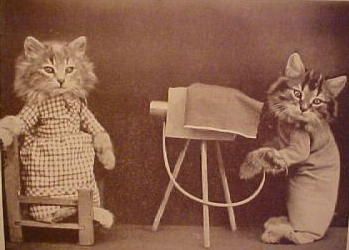 The cat’s out of the bag -- almost literally -- now that the U.S. and Russia have declassified some of their cold-war spy reports. But until now, nobody has reported on the littlest, the warmest, the cuddliest, the most technologically surprising secret of them all. It is time for the world to know about Esther, the Cold War kitty.
The cat’s out of the bag -- almost literally -- now that the U.S. and Russia have declassified some of their cold-war spy reports. But until now, nobody has reported on the littlest, the warmest, the cuddliest, the most technologically surprising secret of them all. It is time for the world to know about Esther, the Cold War kitty.
Esther was the West’s secret weapon. With her Minox subminiature camera, she kept an eye on the skulkings and plottings of the Soviet leadership. Josef Stalin, his successor Khrushchev, and the entire leadership of the KGB spy organization loved Esther. They treated her as an honored and pampered guest. They never suspected that the lovable, furry kitty-cat was a subminiature techno spy.
Esther’s story is unlike any other. She was an ordinary cat, living an ordinary life, until one morning in 1947. Suddenly, through no fault of her own, Esther found herself on an airplane to Vienna.
In the years right after World War II, the Austrian capital city was a place of intrigue, seething with spies from the Soviet Union, England, the United States, France, and other glamorous countries.
The night before her adventure began, Esther had gone to sleep on a pile of nice, rumpled shirts. The shirts belonged to a house guest who just happened to be a top U.S. spy. When the spy packed his luggage in the pre-dawn darkness, he unknowingly packed Esther. Esther was notorious among her friends for being able to sleep through almost anything.
When she awoke the next day, Esther was in the American consulate in Vienna. The Ambassador and his favorite spy were delighted to meet Esther, and they spent several minutes petting her and giving her treats. But the Ambassador and the spy were preoccupied with a problem. They couldn’t figure out how to get inside the Soviet embassy and take photographs of the Soviet ambassador and his favorite spy.
Suddenly, the two men had a brainstorm. They would have Esther take the photos! Who would suspect an innocent- looking kitty of being a big-time spy? It was a brilliant idea.
The Ambassador showed Esther a very special camera. It was a beautiful little machine, a tiny, kitty-sized Minox (see photo below). The Minox had been designed a decade earlier in Latvia by a Swiss inventor named Walter Zapp. The camera was a mere 75 millimeters long, 13 millimeters high, and 28 millimeters wide -- just perfect for a cat. It weighed 180 grams, and used very small film, just 8 by 11 millimeters. With a Complan 15mm F3.5 (4Ele, 3Grp) lens, a Galilei Bright flame finder, a 0.2 - Infinity thumb wheel dial, shutter speeds from 1/2-1/1000 s, and the ability to shoot from as close as 0.2 m, the Minox was ideal for Esther. All it needed was a way for her to snap the shutter. Esther herself helped devise a paw-activated trip mechanism.
 (Image credit: Flickr user David Bruce)
(Image credit: Flickr user David Bruce)
Esther was more lovable than any cat on the Continent. With the Minox strapped under her leg, she could go anywhere and take pictures of anything. And she did. Esther was a personal houseguest of both Stalin and Khrushchev. She attended Communist party congresses and top-secret military meetings.
Because Esther was an extraordinarily furry cat, no one ever noticed that she came equipped with a Minox. The furriness did create one problem, though -- a big one. Most of Esther’s photographs show more fur than anything else (see example, right). Of the more than twenty thousand pictures she produced, only a handful show anything that a human being can recognize. Esther died in 1962. Had she lived and worked a mere three decades later, new image processing technology would have been available to turn her furry photos into useful strategic tools. For Esther the Cold War kitty, opportunity came too soon.
Esther and the Soviet Gear Factory
The photographs you see here were taken in 1948 at a gear factory near Omsk, in the Soviet Union. The photographer was Esther, the Cold War kitty. Esther was a lovable, furry cat who became Josef Stalin’s favorite pet. Secretly, though, she was a spy for America. Stalin and the other Soviet leaders took Esther everywhere, and everywhere she went Esther took pictures with her Minox subminiature camera. The Omsk gear factory photographs were one of her triumphs, because they revealed a great secret the Russians didn’t want the West to know.
Stalin always loved to visit gear factories. That’s because his name, “Stalin,” is a Russian word that means “steel.” Good gears are made of steel, you know.
The visit to the Omsk gear factory began as a typical Stalin trip. The great leader packed a box lunch and some snacks, and a snuggly blanket for Esther so she would be comfortable on the long train ride. Stalin and Esther rode right up in the front car, with the engineer. Stalin got to flick the train whistle switch on and off the whole time. Esther slept through it (she could sleep through anything). When the train arrived in Omsk, Stalin let everyone on the train touch his mustache. Then he and Esther went over to the gear factory, where he let everyone in the factory touch his mustache. Then he toured through the factory, flicking all the switches on and off. The factory workers applauded and cheered. It was a fun time for everybody.

There was hard work to be done, too. The first photo shows Josef Stalin disassembling a double- reduction locked-train speed-reduction gear. This particular photograph is important evidence. If you look very, very, very carefully, you’ll see that this particular double-reduction locked- train speed-reduction gear has tiny words printed on it. They say “MADE IN AMERICA.” Thanks to Esther’s photograph, the West discovered that the Soviet Union had been stealing American high-tech secrets! And that Josef Stalin knew about it!
And that’s not all Esther discovered. On this particular visit, she apparently crawled into a sunny corner of the factory and dozed off. Stalin went home to the Kremlin, not noticing that his beloved kitty had been left behind. Esther spent the next two days at the factory.
This was a fortunate thing for England and America. The second photograph shows what the factory was like on a typical work day. You can see everybody standing around in a big group. That’s what the workers did every day, all day. The factory director always read aloud to them from Josef Stalin’s best-selling book “How to Design and Manufacture Gears.” Out of respect for Stalin, the workers would remain standing while they listened. The best part was chapter 43, “Tooth Proportions for Cross-Helical Gears and Double-Enveloping Worm Gears.” Everyone agreed it was a corker.
The factory workers enjoyed hearing their director read Stalin’s book to them, over and over and over again. But they were a little sad because their feet hurt, and because they never had time to make any gears. Maybe that’s why the Soviet Union had to steal gears from the United States.
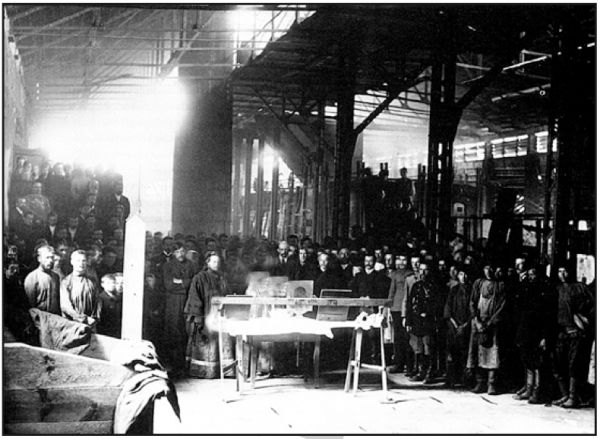
Now, there WAS one Russian gear factory where they DID make gears. It was in Novosibirsk.
The factory director there didn’t know how to read, so the workers never got to hear Stalin’s book. Instead, they sat down and made gears. They made them of iron. One worker made the iron gear hubs. Another worker made the iron gear teeth. A third worker glued the gear teeth onto the gear hubs, then washed the whole thing in nice, clean water to make it shiny.
It was a really small factory -- three workers and an illiterate director. Esther never got to visit the place, because Stalin never went there. This was a small failing in her otherwise sterling career.
Esther and the Soviet Oil Field
You wouldn’t think that oil and gasoline would interest a cat, and ordinarily you’d be right. But there was nothing ordinary about the career of Esther, the Cold War kitty.
Equipped only with her Minox subminiature camera, her cuteness and charm, and an abundance of fur, Esther lived and traveled with Josef Stalin, Nikita Khrushchev, and other Soviet leaders. She saw and photographed every Russian secret, great and small. This humble kitty took more than twenty thousand pictures. The pictures showed mostly fur, because Esther was a very furry kitty indeed. But there was valuable information in some of them, if you looked carefully.
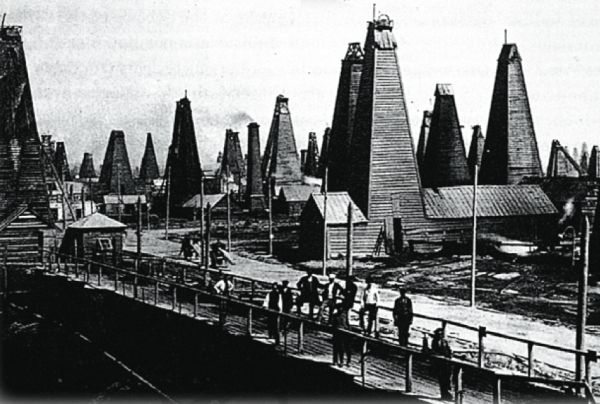
The picture you see here was one of Esther’s early triumphs. It shows the oil fields at Baku. Every summer from 1947 to 1951, Esther went to Lake Baku, with Josef Stalin. Stalin liked to go snorkeling and build sand-castles and fly kites, while Esther cat-napped on a plush linen blanket on the beach. It was a fun time for everybody.
People outside the Soviet Union were very, very eager to see what was happening at Baku. Newsreel producers were desperate to get film of Stalin frolicking in the sun and sand, because he was a big international celebrity. Western governments and business leaders, though, needed to know about the oil situation.
Russia was powered by oil and coal. They used the oil to make gasoline and specialty lubricants and paraffins. Most of Russia’s oil came from Baku and the other oil-producing fields of the Chechen-Ingushetiya region. When the cold war began, no one in America or England knew how much oil the Russians had. The West was worried. Maybe Josef Stalin had so much oil that he would become the richest man in the world. If that happened, he would be able to do lots of bad things, and cause lots of trouble, whenever he wanted. It was a scary situation.
Esther’s photograph of the Baku oil fields made the West very happy. It shows lots of big wooden buildings that have oil pumps in them. They look like they could pump a whole lot of oil out of the ground. That would be a frightening thing, wouldn’t it, if Josef Stalin were getting all that oil every day, and he could do whatever he wanted with it? But you don’t have to worry about that, because the picture tells a very different tale.
Long, long ago -- about 1890 -- the oil fields at Baku were pretty new, and the oil pumps there were pretty small, and pretty rickety. Sixty years later, when Esther was doing her spying in Russia, the oil industry outside Russia had invented big, shiny oil pumps that were very powerful, and could pump lots of oil.
But the oil pumps in Baku were NOT big, or shiny, or powerful. Look at Esther’s photograph carefully. The oil pumps you see there are small and rickety. They are the same old oil pumps from 1890. What Esther showed was that Russia was very behind-the-times, and was only using dinky old pumps.
So the Soviet Union wasn’t producing very much oil at all. And so Josef Stalin would NOT become the richest man in the world, as well as one of its most powerful men. And so he would NOT be able to do lots of bad things, and cause lots of trouble, whenever he wanted. The situation was not so scary, after all.
Once the Western leaders saw this photograph, they were able to stop worrying about the Soviet oil industry. They could relax, and find other things to worry about. And this was all thanks to the valiant work of Esther the Cold War kitty, and her Minox subminiature camera.
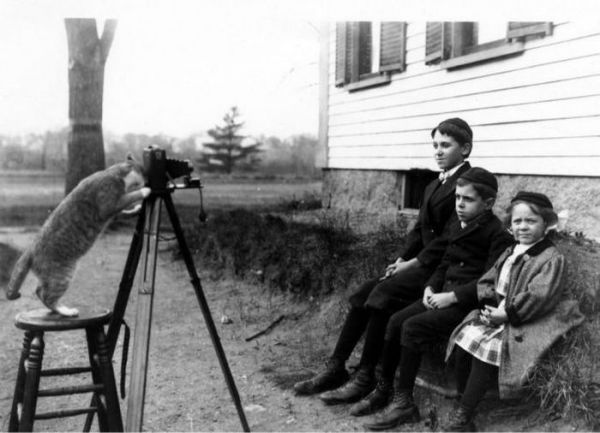
_____________________
 This article is republished with permission from the September-October 2005 issue of the Annals of Improbable Research. You can download or purchase back issues of the magazine, or subscribe to receive future issues. Or get a subscription for someone as a gift!
This article is republished with permission from the September-October 2005 issue of the Annals of Improbable Research. You can download or purchase back issues of the magazine, or subscribe to receive future issues. Or get a subscription for someone as a gift!
Visit their website for more research that makes people LAUGH and then THINK.






